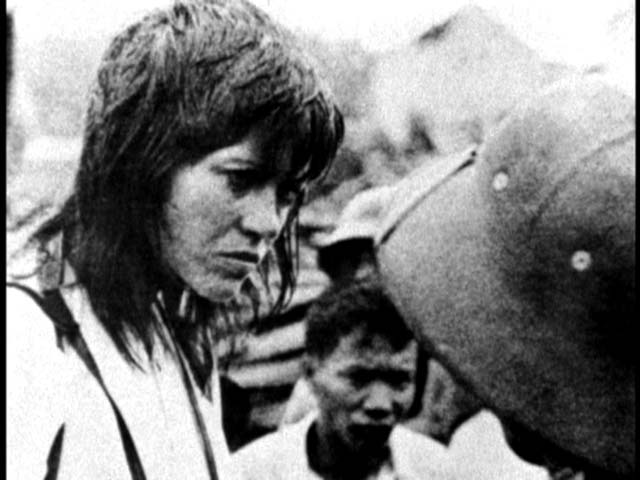Retrospectives
Letter to Jane (1975 review)
Letter to Jane
France, 1972
Directors: Jean-Luc Godard, Jean-Pierre Gorin
Letter to Jane was initially made to be shown in a specific limited context: as a short accompanying Tout va bien at the New York and San Francisco Film Festivals in 1972. As with all of Godard and Gorin’s joint projects, the essential aims of the film are demystification and political analysis. More generally, it pursues a demystification of cinema itself as art object, reflected in the minimal technical means used in the articulation of the filmmakers’ argument (a montage of stills separated by cuts or makeshift wipes accompanied by the voices of Godard and Gorin in English, with brief uses of recorded music as punctuation) — an approach further developed by Godard’s more recent work with video, which seeks to demonstrate that the “production of sounds and images” need not be as expensive or as technically elaborate as is usually supposed. More concretely, Letter to Jane sets out to analyze and demystify a single photograph of Jane Fonda with North Vietnamese which appeared in an August 1972 issue of L’Express. The picture shows Fonda in the left foreground in three-quarters profile looking at a Vietnamese in the right foreground whose face is almost entirely obscured by a sun helmet and the fact that he is looking at Fonda and away from the camera; in between these figures are other Vietnamese in less sharp focus, only one of whom is clearly visible — a man who appears to be looking between the two foreground figures at the camera. Starting with the question, “What role should intellectuals play in the revolution?” — an issue informing Tout va bien as well (which is a frequent reference point, in terms of off-screen commentary as well as stills) — Godard and Gorin proceed to interrogate both the picture and our responses to it; it is important to know, Godard says, “how each [of us] has used this photograph to go to Vietnam”. Central to the analysis is the statement that Fonda’s facial expression is “that of a tragic actress”: comparative stills of Fonda in Klute, her father Henry in The Grapes of Wrath and Young Mr. Lincoln, and John Wayne in The Green Berets are shown as examples of what is described as the “New Deal” look, “an expression of an expression” that “talks, but only to say how much it knows” and “nothing more than how much it knows”. This is contrasted with stills illustrating the “materialist starting point” of silent cinema, where “the expression of silence creates stars — Lillian Gish, Valentino, Falconetti”, and (to paraphrase) the actors thought about being filmed rather than about being actors (as in the talkies). Still another ideological point is raised about the presumed low angle of the photograph in relation to Fonda — a somewhat debatable point because none of the people are seen below the torso, and it isn’t clear whether or not Fonda might be standing on a higher plane — which is compared with stills from Welles’ first two features. The paradox of Letter to Jane, like so much of Godard’s post-1968 work, is that it reveals a poetic sensibility attempting to divest itself of poetry with little more than poetic intuition as its guide. The strengths of the film are its perceptions and insights — which are many, about the photograph and how it is read; its limitations lie in the implicit, naïve assumption that these discoveries are “scientific” — thus presumably exempt from those forms of rhetoric found in the photo – and in the ensuing confusions, which are also many. It is worth noting that 2 or 3 Things I Know About Her, Le Gai Savoir, and Vent d’est avoid this error, all three films raising basic questions about their own language as well as the language of others; but these works are still bound up in poetics, if only out of habit. In Letter to Jane, it would perhaps be more correct to say that poetics ultimately get in the way of the argument, because they wind up furnishing as much ideological rhetoric as they strip away. Having exposed the “New Deal” look of Fonda, Godard and Gorin go on to assert that the Vietnamese face in the background “remains a part of his surroundings even if we try to look at it alone” and “has a definite reverse shot” (i.e., reverse angle, a contingent reality); “behind him we can already feel the force of the astonishing incredible machine built by the North Vietnam-Viet Cong collective”. Moreover, “no other revolutionary’s face expresses as much daily struggle as this one”. In short, a poetical insight squared by a political-emotional commitment — a fusion that can be seen quite sympathetically in its own terms –- passes without warning or acknowledgment from formal analysis to metaphor to platitude, a distance traversed many times in the film. The issue is not whether “poetry” and “science” (or “objective analysis”) are imcompatible — Eisenstein, Vertov, Snow, and the Kubrick of 2001 have all demonstrated that they need not be — but whether they can be reconciled within the restricted framework of An Investigation About a Still (the subtitle of Letter to Jane, which inadvertently reveals that the authors are not speaking their mother tongue). But if the final effect of Letter to Jane remains unsatisfactory and incomplete – virtually nothing is said, for instance, about the Vietnamese figure in the foreground, and the overall presentation is rambling and loose — it is none the less invigorating, engendering a process of examination which can proceed far beyond the point to which Godard and Gorin have taken it.
Jonathan ROSENBAUM
first published in:
http://tiny.cc/91dzhz


